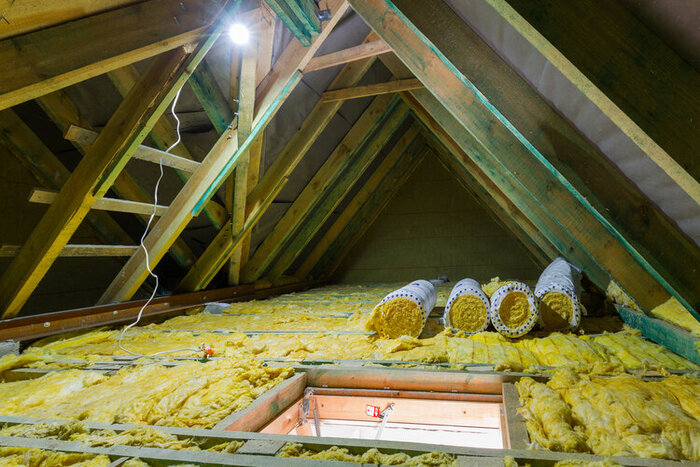
Have you been experiencing colder winters lately? Is your house an older structure with an attic? If it is, you need to look into adding proper insulation to your home.
The energy efficiency of a house can cut down on costs bigtime. An example is how water heating uses around 90% of the energy it takes to operate a washer. Modern washing machines can clean your clothes without hot water.
The insulation heat loss of your home can lead to paying a higher bill than cutting down on it. So how do you keep your home warm in the winter seasons without emptying your wallet? The key is to invest in insulating your attic.
Below, we will give you a guide on how to insulate an old house.
We all know that hot air rises as cool air sinks to a low level. Let’s apply this knowledge to your house. Without proper insulation, in the winter months, the warm air you need will seep up to the attic.
No matter how small the gaps that lead up to your attic, warm air will find ways to go up. Other than that, the pressure in the area with warm air will increase. On a cold day, that pressure and the lower pressure from outside pull the warm air through any gap in can find.
Other than that, the high air pressure at the top of the house will create low pressure at the bottom. The cold air gets pulled in because of these different air pressures, making your home frigid. This is what energy experts call the stack effect.
Before you insulate your attic, read these pre-insulation steps first.
Your insulated attic isn’t necessarily a sealed attic. Before you begin the installation of insulation, you have to make sure to seal all the gaps in your attic. Insulation works to slow down heat loss but not to stop airflow.
Check all the gaps and holes where air can pass then seal them up. Cover gaps with planks or drywall pieces. You can also use latex caulk or urethane foam for wider gaps.
Check gaps from light fixtures, pipes, wiring, and heating/cooling ducts. For chimneys and stove flues, use sheet-metal collar and caulk to seal gaps around them. Use weather stripping around the edges of your attic door for an attic door seal,
Warm air can also leave through your attic ventilation. In the summer, vents in the attic keep the house nice and cool. In the winter months, you want to cover your attic vents if you can.
Attics that are already insulated will need more elbow grease. Roll back batts so you can seal all the gaps under them. Remember your safety gear: pants, long sleeves, gloves, eye protection, and a dust mask.
What if the attic has loose-fill insulation, which you can’t pull back? It’s better for you to call a weatherization contractor to find all the gaps and holes. Don’t leave a breach for warm air to escape through.
The answer to making an old house inhabitable is insulation. Even if you bought the house with insulation already installed into it, it’s best to double check. The insulation materials used in older houses are not as effective in keeping heat in as the new ones.
The insulation must meet DOE standards. For most of the US, the DOE’s standard is R-38. Your area may have a different standard so be sure to check first.
You have many choices for your insulation batting. The traditional option is fiberglass insulation. When you choose this solution and work at it alone, be careful and wear safety gear.
You can add R-30 insulation batting throughout your attic. Or, you can also use blown-in insulation which has environment-friendly materials available. A 15-inch thickness is like the R-30 insulation batting.
For a greener insulation project, Cellulose blown-in insulation is available. Recycled newsprint makes up cellulose. The R-value is greater than fiberglass and it is fire-retardant.
The best way to insulate attic doors is to make a pillow made of insulation batting. Measure first before you stick it onto the attic door with tape. Add foam to the edges to keep it air-sealed.
Did you know that 42% of the energy used in homes goes to space heating? Compare it to the energy air conditioning uses up, which is 6%. When it comes to keeping the house habitable temperature-wise, homeowners use up more energy and money in colder seasons.
For the most part, the attic is a big factor in heat loss. Still, that doesn’t mean we should ignore other common heat leaks. The following are other measures you can take to keep heat in.
After the attic, windows are the second major problem. Make sure you have storm windows in place. Next, keep your exterior walls insulated as well.
Check your home for other gaps. Follow pips, cables, or drains that may lead outside the home. If you find any, seal them up to keep heat in.
When you insulate light fixtures, make sure your insulation materials are a good distance away from the heat of the lights. You may need to install wooden blocks around the lights. Insulation materials too close to the heat generated by the lights can cause fires.
Before you seal or insulate your attic, it’s best to clear it out first. This way, it’s easier to remove the plywood on the attic floor. Before you peel away the plywood, assess its condition if it’s fit for insulation.
Check your current insulation for dampness. The presence of molds and stains means that it’s time to change them. All these steps on how to insulate an old house are great investments in energy savings.
Don’t wait to insulate! Feel free to contact us today and we can help you get started. If you’re not so sure yet, don’t worry about the cost because we offer free estimates as well!